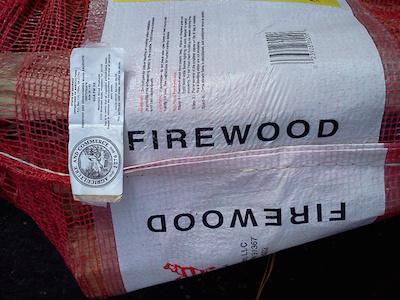
Beginning in March, only heat-treated firewood, and wood collected within the park, will be allowed in campgrounds at Great Smoky Mountains National Park/NPS
In a further step to help protect the forests of Great Smoky Mountains National Park from non-native insect pests, park officials beginning in March will only allow heat-treated firewood that has been certified by the USDA or a state agriculture department, and dead and down wood collected from the park's forests, to be used in campgrounds.
Heat-treated firewood will be available to purchase from concessioners in many of the campgrounds as well as from private businesses in the communities around the park. Certified heat-treated firewood is packaged in 0.75 cu-ft. bundles clearly displaying a certification stamp. The wood is a high-quality hardwood product that has been heated for 60 minutes at 140 degrees Fahrenheit. The wood lights easily, burns well for campfires, is safe to cook over, and is already available at over 85 locations near the park that can be viewed on an interactive map by visiting www.nature.org/firewoodmap, according to park officials.
In addition, visitors may still collect dead and down wood in the park for campfires.
'The threat of these new pests coming into our forests, both in the park and regionally, compels us to do all we can to reduce the risk to our forests,' said acting Superintendent Clayton Jordan. 'While a ban on the importation of non-treated firewood will not entirely halt the spread of destructive forest pests and diseases, it will greatly slow it down. This allows time to develop and implement new treatment strategies to help control the impacts from these non-native pests and diseases.'
Non-native, tree-killing insects and diseases can unknowingly be introduced through firewood transported from infested areas. A variety of destructive pests lay eggs or stowaway in firewood. These insects from Asia and Europe have the potential to devastate more than 30 species of hardwood trees native to the park. New infestations threaten the forests with widespread tree mortality that could devastate wildlife habitat, biodiversity, and scenic views, a park release said. The use of firewood that has been heat-treated eliminates the threat posed by these pests through the movement and use of wood in campfires.
National parks throughout the Appalachian region have taken action to limit the spread of insect pests in firewood including, in many cases, the banning of imported firewood. For the past three years, the Smokies has prohibited the importation of firewood from areas quarantined by the USDA Animal Plant Health Inspection Service.
Park rangers have been working over the past year with numerous partners representing federal and state agencies, conservation organizations, and universities to mitigate the risks associated with movement of firewood including a public education campaign with campground programs and regionally placed billboards. The park also hosted public meetings and developed an informational handout that was provided to all Smokies campers throughout the summer inviting public comments.
For more information about firewood and forest and insect pests in the park, check out this webpage.



Comments
This should probably be a rule for all parks. It is a great precaution given the spread of Emerald ash borer, etc..
More and more as I travel I'm seeing signs asking that campers use "local" firewood to avoid importing pests from somewhere else. So far it appears to be voluntary. So it looks like GRSM is not unique in this effort.
References
http://www.ecobooks.com/books/dying.htm
Also:
http://www.fs.fed.us/rm/pubs_rm/rm_gtr267/rm_gtr267_105_113.pdf
http://www.nature.org/ourinitiatives/habitats/forests/fading-forests-3-c...
A Forgotten Book To both Study and Include In Park Libraries
The Dying of the Trees
The Pandemic in America's Forests
by Charles E. Little
275 pages, paperback , Penguin, 1997
From the sugarbush of Vermont and the dogwoods of Maryland's Catoctin Mountains to the forests of the hollows in Appalachia, the oaks and aspens of northern Michigan and the mountainsides and deserts of California, a range of human-caused maladies-- fatal ozone, ultraviolet rays, acid rain, and the disastrous aftermath of clear-cutting--has brought tree death and forest decline.
In The Dying of the Trees, veteran environmentalist Charles Little explores this phenomenon with scientists, government officials, and citizen leaders and recounts how they have responded (and in many cases failed to respond) to this threat to global ecological balance. What emerges is a fascinating, well-rounded, and sobering account of this disturbing trend, what it forebodes for the future of the Earth, and what must be done to save our trees.